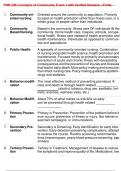PNR 208 Concepts of Community Exam 1 with Verified Answers – Fortis.
1. Community-ori- Oriented around the community or population. Primarily
ented nursing focused on health promotion rather than illness care, in a
whole group of people rather than individuals.
2. Community Based in the community. Illness care OF individuals IN the
Based Nursing community. Home health care, hospice, schools, occupa-
tional health. Illness care instead of health promotion and
health maintenance. Individuals as opposed to communi-
ties and populations.
3. Public Health A specialty of community-oriented nursing. Combination
of nursing and public health science, health promotion and
maintenance. Focused mostly on primarily and secondary
prevention of acute and chronic illness with devastating
consequences and the prevention of injuries and illnesses
that lead to early death. More policy making and execution
than direct nursing care. Policy making guided by epidemi-
ology and statistics.
4. Behavior modifi- The most effective method of preventing premature ill-
cation ness and death is through health-related
(alcohol, tobacco, drug use, seatbelts, hel-
mets, exercise, wellness visits, etc.)
5. Behavior Modifi- About 70% of what makes us sick/kills us early
cation can be prevented through health related
6. Primary Preven- Primary is Prevention: Prevention of the problem before it
tion ever occurs; prevention of illness or injury, like helmet or
seat belt campaigns, or immunizations.
7. Secondary Pre- Secondary is Screening. Early identification for early inter-
vention vention. Early detection preventing complications, attempt
to reverse the course. Routine screening recommenda-
tions (mammogram, yearly blood pressure screening, pap
smears)
8. Tertiary Preven- Tertiary is Treatment. Management of disease to reduce
tion the symptoms and improve quality of life. Medications, low
, PNR 208 Concepts of Community Exam 1 with Verified Answers – Fortis.
Na+ diet, checking blood glucose in diabetic, weight loss
for someone with HTN or T2DM, etc.
9. Uninsured and these individuals generally receive less preventive care ,
underinsured are Dx'd at more advanced stages of disease, and receive
fewer therapeutic care once Dx'd than those with high
quality health insurance.
10. Affordable Care This law improved access to healthcare through providing
Act government subsidies for those who couldn't afford em-
ployer based or private insurance and through mandates
that required individuals to carry health insurance or be
penalized. It did not reduce the costs of high tech medical
care. It shifted the focus toward population level interven-
tions. it also expanded Medicaid eligibility.
11. Uninsured indi- What is impacting health care system in the US?
viduals, access
to quality health
care based on
insured status,
longer life ex-
pectancy, baby
boomers, afford-
able care act, un-
employment.
12. Vulnerability susceptibility to actual or potential stressors that may lead
to an adverse effect; increased risk for adverse health out-
comes. Genetic risks leading to more severe health out-
comes from pollution, lead based paint, excessive noise,
etc.
13. Epidemiological Describes the relationship that can lead to illness. The
Triangle triangle is made of:
-the host, or the people who may get sick
-the agent, or the disease causing microbe, chemical or
behavior
-the environment, or what surrounds the host that con-




